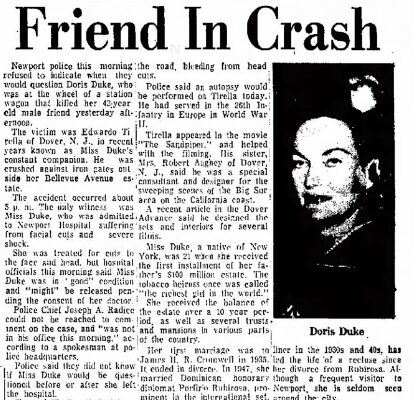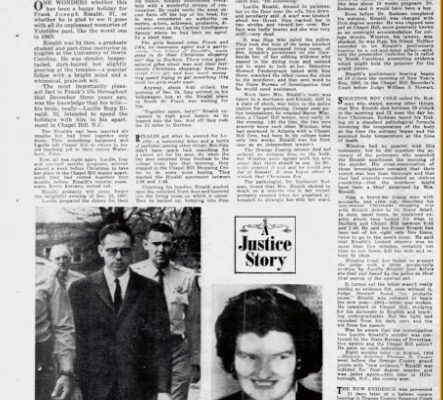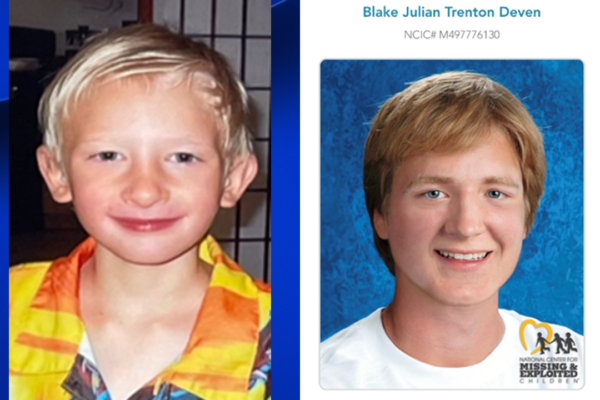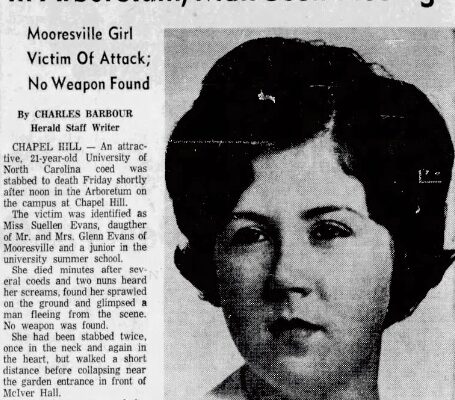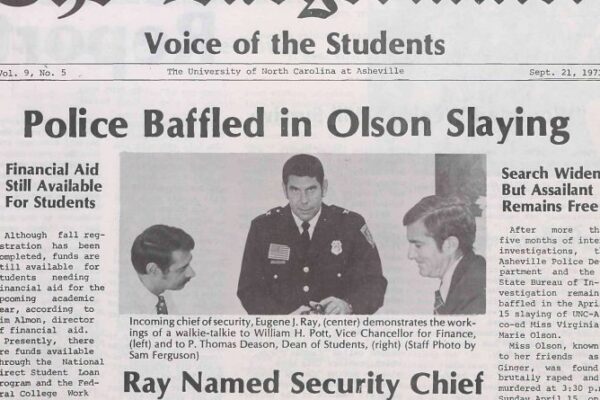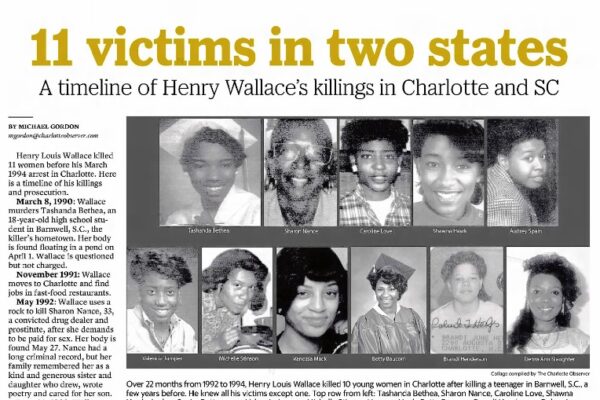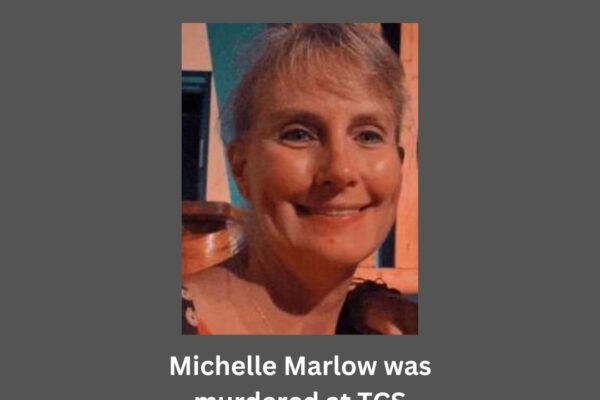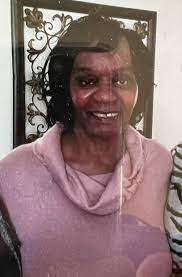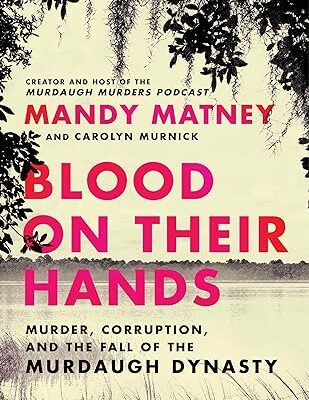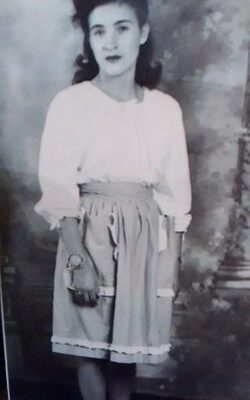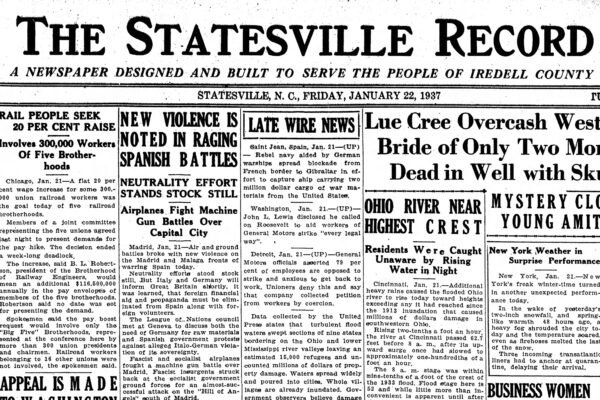Carrie Wikerson and Jean Fewel
On February 22, 1984, 7-year-old Carrie Wilkerson failed to report to school at Frank Porter Graham Elementary in Carrboro. That morning, firefighters investigating a fire at the Rocky Brook Trailer Park off South Greensboro Street discovered the body of Carrie in the bedroom closet of her stepmother Norma Shivers’ home. Carrie was the birth daughter of Shivers’ first husband, and she had stayed with her step-mother after the two divorced. The little girl had been sexually assaulted and strangled before a fire started and damaged part of the trailer. It appeared a kerosene heater with some clothes laid on top of it had ignited and started the fire.
Shivers told the police she normally left for work around 7:30 a.m., and Carrie would get herself ready for school and walk with two other girls from their neighborhood. But the girls said when they knocked on the door for Carrie that morning, she told them she was with a friend and would come to school later. When they asked who the friend was, she said it was “none of their business.”
Shivers said around the same time firefighters were discovering the fire at the mobile home, a man called North Carolina Memorial Hospital, where she worked, and asked the nurse who answered the phone to tell Norma he’d killed Carrie and he was sorry. Earlier that morning, another call had come into the O.R. asking for Norma, but she said when she answered the line the caller hung up. She said she suspected the caller had been George Fisher, the husband of a co-worker and friend at the hospital, because he was the only person she knew who had both of those telephone numbers.
Unfortunately, there was more than one suspicious person lurking in Carrie Wilkerson’s life. Shivers’ own brother, a man named Eddie Hathaway, had admitted to molesting Carrie a few weeks earlier. He was a prime suspect in the eyes of the police.
In April 1984, Edith Page, Carrie’s maternal grandmother, offered a $5,000 reward for information leading to a conviction in the death of her granddaughter. The office of Governor James B. Hunt, Jr. was also offering a $5,000 reward, along with one for $100 to $10,000 from an arson awareness committee in Raleigh. Edith Page told the local media that she could understand people not wanting to get involved, but was hoping the reward would encourage someone to come forward.
But with physical evidence tying any of the suspects to the crime, and no one coming forward with additional tips, the case went cold. A year later, another little girl lost her life in the early morning hours before school.
That morning, on January 30, 1985, a man walking his dog at the Mason Farm Biological Reserve in Chapel Hill near the Finley Golf Course discovered the body of a young girl hanging from a tree, a rope coated in plastic wrapped around her neck in a slip knot. She was wearing green corduroy pants, pink jogging shoes, a light blue quilted jacket and blue shirt with the words “Do it Yourself” printed on it.
Police soon learned 8-year-old Jean Kar-Har Fewel had been walking to Ephesus Road Elementary School with her 12-year-old brother before she failed to report to her classroom. She had moved to Chapel Hill from Hong Kong the year before and was in the process of being adopted by Thomas Fewel and Joy Wood. A former Sunday school teacher described Jean as a highly active, curious, happy child who loved to have her picture taken.
At first, police announced they were unsure of whether the little girl’s death was the result of a suicide or a homicide. After setting up a special hotline asking for tips on the case, the Chapel Hill Police Department received a number of calls. Witnesses told police they had seen Jean in the passenger seat of a car was described as mid-1970 four-door Plymouth Satellite with a tan or light-colored vinyl top. Other neighbors of Jean said they had seen that car driving around Jean’s neighborhood that morning before she left for school, and speeding away from where Jean’s body was found around 8:45. Police soon figured out George Richard Fisher, the family friend of Norma Shivers, drove a car matching that description. When shown a photo, two witnesses identified Fisher, who was wearing a distinctive pair of black-framed glasses, as the man who was with Jean before her body was discovered. In fact, local residents said he was often seen around the school, even though he had no business being near the grounds. He was arrested on February 4, 1985, and charged with first-degree murder, kidnapping, and rape in the death of Jean Fewel.
Hair and fabric similar to the clothing Jean was wearing the day she was murdered were found in a search of Fisher’s car. When he went on trial in August 1985, his attorney argued that evidence presented in the case showed the possibility that his client was involved in the case, but did not prove necessarily prove guilt. Fisher testified on his own behalf, and he presented a long, rambling timeline of his actions on the morning Jean was murdered that didn’t necessarily paint him in a positive light. He said he left for work that morning around 6:15 a.m., but found his car was stuck in the mud. He realized he wasn’t feeling well and feared he might have caught the flu from his wife, a registered nurse. But,he went to pick up two of his co-workers who lived in a halfway house for recovering alcoholics near the University Mall.
They never came out for their ride, though, even after he honked his horn in front of the halfway house. Fisher then went to a convenience store to buy gas, coffee, and a pastry. A clerk at that convenience store later testified Fisher had bought coffee and a cinnamon twist pastry, an item of food that matched one that was found in Jean Fewel’s lunchbox later that morning. After leaving the gas station, he claimed he went to an adult bookstore to see if any of his friends were there and watch pornographic movies. However, he couldn’t provide the name of the adult bookstore. He stayed there for two hours, then went to the office of his employer to pick up a W-2 form. The bookkeeper confirmed he had been there around 10:30 a.m. to pick up the paperwork. He then went home and watched television until his wife returned from work.
A fiber analyst with the State Bureau of Investigation said he performed tests that showed 18 positive connections involving fibers from Jean’s clothes and Fisher’s clothes and car. An expert for the defense testified that the fibers found in the car that police believed belonged to Jean could have come from other sources. Fisher claimed he often picked up hitch hikers in his car so fibers could have been transferred from them. An expert for the prosecution testified that semen found on Jean’s shirt could have come from Fisher, and seven dark hairs found in his car could have belonged to Jean.
As The Chapel Hill News pointed out, the murders of Carrie Wilkerson and Jean Fewel were very similar. Both the victims were second-graders in the community with dark brown hair. They were both murdered in the early morning hours before school. Both involved sexual assaults or attempts and strangulation.
Fisher had served time in both an Ohio psychiatric hospital and North Carolina prison for arson convictions in both states. He had been on parole since 1982.
On August 21, 1985, a jury found George Fisher guilty in the murder, attempted rape, and kidnapping in the death of Jean Fewel. He received a life sentence for first-degree murder, 40 years for kidnapping, and 20 years for attempted rape. He also received 22 years for violating his parole, after being convicted in 1974 for arson, breaking and entering, and larceny in Onslow County. During the sentencing hearing, Jean’s adoptive father, Tom Fewel, asked that Fisher’s life be spared. He said, “I am opposed to capital punishment. I believe that every human life is sacred, that its sanctity is imposed to every human being by God. There is no sentence that could be imposed on Fisher that could bring Jean back to me.”
After Fisher was sent to prison for Jean’s murder, police collected blood and hair samples from him. They found a picture of Fisher with Carrie Wilkerson when they searched his home in February of 1984. The samples did not link him to Carrie’s death, and he denied killing her, so he was not charged with the crime.
New Lead Points to Old Suspect
In 2010, investigators had received a call about possible new information in Carrie’s case. While the information did not lead to a new suspect, it prompted the State Bureau of Investigation and Carrboro to take another look at her case. It was then they discovered DNA evidence from a bedspread kept in a rape kit at the Carrboro Police Department finally conclusively linked Fisher to Carrie’s rape and murder in June 2010.
Looking back, they discovered that Fisher had been employed by a construction company that worked on the Dean Smith Center at the UNC campus. He had not been at work both mornings Carrie Wilkerson and Jean Fewel were murdered.
When confronted with the evidence, Fisher agreed to plead guilty to the first-degree murder and rape of Carrie Wilkerson, along with first-degree arson. Superior Court Judge Carl Fox gave Fisher two additional life sentences, plus another 15 years for an arson charge, all to run one after another. He would have been eligible for parole the following month if not for the new convictions related to Carrie Wilkerson’s murder.
Carrie’s stepmother, Norma Shivers, said she had long suspected Fisher was involved in Carrie’s murder. “We knew who it was,” she told local media outlets. “They just didn’t have the evidence. I’ve known it all along.”
Carrboro Police Captain J.G. Booker confirmed the use of new DNA identification technology at the time proved to be the break officers had long been looking for in the case. He added, “You may have a strong suspicion, but without evidence you can’t provie it in court. You have that glimmer of hope that something will break.”
He also told the public that while there was a lot of focus on Fisher as the perpetrator, it was important to remember that a young girl’s life was taken away from her before she ever got the chance to live it.
George Richard Fisher remains incarcerated at Maury Correctional Institution in Hookerton, North Carolina.
Thomas “Perry” Zimmerman
In early 1985, a UNC student was murdered in what appeared to be a burglary that occurred while he was visiting friends off campus. On February 21, 1985 21-year-old UNC student Thomas Perry Zimmerman was visiting with three other friends at the Hilltop Trailer Court, located about four miles from the university campus. Resident Robert Wimberly said he was in the kitchen serving dinner when a masked intruder entered through the front door, holding a gun. A few minutes later, another masked man joined in, and Robert and two of his other roommates, William Bullock and James Youngman were beaten with 2 x 4’s the men had brought in. While the men were lying on the floor, along with Perry, the intruders ransacked the trailer and found an ounce of marijuana hidden behind some record albums and demanded to know where the rest of it was.
Robert said he recognized one of the voices as that of Richard Sanders, based on several different conversations he’d had with him in the past, including selling him drugs. James Youngman said he recognized Steven Sanders because he had attended high school with him in Chatham County.
A Shot Rings Out
Robert Wimberly and James Youngman, were robbed of about $21. There were a few moments of silence while the men tried to determine if the intruders were gone, and then they heard a gunshot and Perry Zimmerman screaming. They were both treated for lacerations on their heads later that night at North Carolina Memorial Hospital. Perry was pronounced later dead upon arrival at the North Carolina Memorial Hospital from his injuries.
A High Point native, he was a journalism major who resided on the UNC campus. A friend told The Daily Tar Heel he didn’t know the men Perry was visiting on that night, but that he liked to go hang out with friends and play the guitar at their trailer. Another friend remembered Perry as an energetic, responsible person who was eccentric in a positive way. He enjoyed astronomy, creative writing, playing Dungeons and Dragons and penning short stories. During their freshman year orientation, Perry didn’t like the name tags given out to students, so he wrote “Captain Zap” on his and said it enabled him to meet more people that way.
Twenty-two-year-old Richard Anthony Sanders and 21-year-old Steven Wallace Sanders were arrested and charged with first-degree murder, first-degree burglary, two counts of armed robbery, and one count of attempted armed robbery.
During their trial in June of 1985, their defense attorney, Kirk Osborn, argued to jurors that the brothers were in the home to buy marijuana when Perry was shot, but that the college senior was shot when a fight broke out over the deal. He suggested the jurors should have reasonable doubt about who actually shot Perry. He suggested the roommates had worked together to conceal their involvement in the fight that left Perry dead.
Friends and co-workers of Richard Anthony Sanders and Steven Wallace Sanders testified that the two brothers were known as likeable young men with a good work ethic. A jury found the two men, who were only 10 ½ months apart, guilty of murdering Perry Zimmerman. Judge Wiley Bowen gave them life sentences, combining charges of first-degree murder, armed robbery, and attempted armed robbery. He handed down additional 14-year sentences against each man for first-degree burglary. They were ordered to serve a minimum of 16 years before they would be eligible for parole.
One juror told The News and Observer that she felt the brothers were given a “wonderful opportunity to turn themselves around, and that played heavily upon the jury’s decision to give them life rather than death.” Their mother, an OR nurse at North Carolina Memorial Hospital, said her two sons had seemed to have more problems after she and their father divorced after a long separation. Perry Zimmerman’s parents were not given a chance to speak at the sentencing hearing. They were upset about that. His mother Louise told reporters that Perry was an outstanding debater and won a trophy in every event he entered, and he was a rising senior at the journalism school at Carolina. She said, “You can’t get that far in school without some worthwhile contribution to society. We couldn’t tell any of that.”
Freshteh Golkho
Just a month after Perry Zimmerman’s murder, on Saturday, March 16, 1985, another violent murder took place in an off-campus apartment called Royal Park near the University of North Carolina.
A young woman named Daphne Pridgen, told police she was watching television in her apartment when she heard a loud commotion and yelling coming next door from the apartment of Freshteh Golkho. Specifically, she heard a woman’s voice yell, “Just let me look at my face.” Around the same time, a resident named Keith Bowles grew concerned when he heard screams while in the laundry room downstairs in the complex. The screams were so concerning he called the police and raced upstairs to wait outside the apartment where Freshteh lived until the police arrived around 10 minutes later. When they arrived, police found the apartment door locked, so they kicked it in. Nineteen-year-old Freshteh Golkho lay dead on the floor, and officers could tell she had been viciously beaten and stabbed. A pair of sweatpants and underwear lay next to her body.
Evidence Left Behind Reveals Suspect
It didn’t take the Carrboro police long to zero in on a suspect. A billfold found on the apartment floor the night of the murder helped narrow down who else had been present at the crime scene. On Sunday, March 17, police arrested 20-year-old Alton Eugene Harris, Jr. of Chapel Hill and charged him with first-degree murder. He was denied bond in the Orange County District Court. Freshteh and Harris were acquainted because he was dating one of Freshteh’s roommates, and it was well known that the two did not get along.
Harris gave a statement to agent Bill Weis with the State Bureau of Investigation. He said he had gone to the apartment to pay back money he owed to his girlfriend. While he was there, he and Freshteh got into an argument, and she threatened him with a butcher knife. He took the knife away from her during a struggle, and she accidentally ran into it, according to Harris. He said he didn’t know why her clothing had been removed. But the autopsy report told a different story. Freshteh had been stabbed 18 times, with three of the wounds piercing her heart. Clothing found at Alton Harris’s apartment matched Freshtech Golkho’s blood type.
Friends and classmates remembered Freshteh in an article published in The Daily Heel just a few days after her murder. Freshteh had moved to Jacksonville, North Carolina from Iran with her mother, father, and sister in 1974. She attended Jacksonville High School and graduated early at the age of 16. She enrolled at UNC for her freshman year, then took a year off to spend time with her family. She re-enrolled for her sophomore year in August of 1984. Freshteh enjoyed watching basketball and dressing up in unusual clothes, like pink, high-topped basketball sneakers. One friend stressed that the three things that made her happiest were peace, love, and God. She couldn’t stand to witness evil, hatred, and pain, which is what eventually surrounded her on the night she was murdered.
Alton Harris’s trial began in October 1985 and included testimony from one of Freshteh’s roommates that the victim had been uneasy whenever Alton was around and disliked how many nights he was spending at the apartment. His girlfriend at the time, Loretta Petty, said Freshteh had barely spoken to her boyfriend and that she merely “tolerated” his presence in the apartment. Investigators presented the physical evidence they had found and the details of Alton’s confession.
A jury found Alton Harris Jr. guilty of felony murder and attempted rape. At his sentencing hearing, two psychiatrists testified that Harris had consumed beer, rum, whiskey, cocaine, and marijuana in the 24 hours before he committed the murder. Dr. Billy Royal told the jury the drugs could create emotional problems and unstable behavior in people who already had underlying problems. These underlying problems included an unstable childhood that included turning to drugs and alcohol at a young age. He had grown up in poverty, living in a log cabin with his parents and four siblings. He and his twin brother had constantly been in trouble while in the Chapel Hill-Carrboro School system, where a former principal testified he felt Harris got into trouble to gain attention and as a cry for help.
An 11-person jury deliberated for four hours before recommending Alton Harris Jr. be sentenced to life in prison for Freshteh’s murder. District Attorney Carl Fox said he was disappointed with the sentence, as he had sought out the death penalty. The victim’s family felt the punishment was just. Alton Eugene Harris Jr. remains incarcerated in a North Carolina prison.
Sharon Stewart
With the community still processing the deaths of Carrie Wilkerson, Jean Fewel, Perry Zimmerman, and Freshteh Golkho all within a year, two female graduate students confronted and one of them went missing with her captor. In the summer of 1985, 23-year-old Sharon Stewart and her roommate Karla Kae Hammett were walking to their car in the Morehead Planetarium parking lot after watching a movie when they felt someone following them.
Sharon, a Cincinnati, Ohio native, had entered the University of North Carolina in the fall of 1984 as a graduate student specializing in speech pathology in the School of Medicine. The Daily Tar Heel reported that while in undergrad at Indiana University, Sharon had been on the dean’s list six out of eight semesters. She was a member of Phi Eta Sigma and the Golden Key Honor Societies. She worked with students needing speech support three mornings a week at the First Baptist Church in Chapel Hill. Karla was also a graduate students in the speech department and the two women lived together at the Kingswood Apartments.
On August 24, 1985, the two women noticed someone following them around 11 p.m. as they were walking down East Franklin Street. They continued on and turned into the parking lot for the planetarium, where Sharon’s 1979 Buick Century was parked. Once they got there, they were confronted by a young, Black male carrying a knife. He grabbed Karla and told the two women to get inside the car and ordered Sharon to drive around the block to the Swain Hall parking lot. He pulled out a pair of handcuffs and put them on Sharon. She asked him to take their purses and the car, and to just she and her roommate go. He ordered Sharon out of the Buick and told Karla to drive around the block and return to pick up Sharon. She complied with his demands and drove out of the parking lot, trying to catch the attention of any nearby cars. Finally, she found a University police car and stopped to let them know they needed help. When they got back to the Swain Hall lot, Sharon and the perpetrator were gone.
Two days later, a police officer in Nashville, Tennessee spotted a young man asleep in a 1977 Chevrolet Silverado pick-up truck that had been reported stolen two days earlier. The car belonged to a man named Howard Wright from Hillsborough, North Carolina. The man sleeping in the truck was Howard’s 16-year-old adopted son, Maxwell Wright. Howard drove to Nashville to pick up his truck, but left Maxwell in jail. But when Howard Wright returned home, he found a purse belonging to Sharon Stewart inside the truck. He turned the purse over to law enforcement on August 29. When FBI agents in Nashville went to question Maxwell, he told them he had kidnapped and robbed Sharon, but would not say whether or not he had killed her. He waived extradition and traveled with agents from the North Carolina State Bureau of Investigation and the FBI from Nashville to Raleigh. Meanwhile, authorities had been searching wooded areas in Orange and Guilford counties, along with the roadsides along Interstate 85, searching for any signs of Sharon.
Making a Deal with a Murderer
Orange County District Attorney Carl Fox was put in a tough spot. Karla Hammett could not positively identify Maxwell Wright as the kidnapper. Blood stains found in the truck the teenager was driving could not be positively matched with the blood of Sharon Stewart. Police could not find any fingerprints belonging to Maxwell in Sharon’s car. Fox told Maxwell Wright that he would not seek a death penalty conviction if Maxwell would confess to murder and lead investigators to Sharon’s body. It was then the young man gave a statement to Bill Weis, an agent with the State Bureau of Investigation, admitting the full extent of his crime.
He said he had put Sharon in the pick-up truck after Karla drove away looking for help. Sharon began struggling with him as he drove down the street, and he stopped the truck near the Chapel Hill Fire Station and stabbed her several times with the small knife he’d been carrying. He then drove on N.C. 86 toward Hillsborough. Before reaching Interstate 85, he noticed Sharon had quit moving and believed she was dead. He stopped the truck, removed Sharon’s body, and put in in the truck bad, after wrapping the young woman inside a piece of carpet that was already in there. He drove on in the direction of Greensboro, finding a convenience store with a construction dumping site behind it. He placed Sharon’s body inside a large barrel on the site and left the scene. On August 30, he led Agent Weis to the location of the convenience store and the place where he had left Sharon. When she was found, her underwear had been removed and she still had a handcuff attached to her left arm.
The Chief Medical Examiner for the State, Dr. Page Hudson, said Sharon had died from multiple stab wounds, including one to the heart, and several blows to her head.
At the sentencing hearing, District Attorney Fox was unable to introduce evidence that Maxwell had attacked a woman in Fayetteville the previous summer in an attempted abduction, because he had been fifteen years old at the time and was still a juvenile under state law.
Maxwell Wright’s friends and family described him as a quiet and polite young man who had never shown signs of violence. They also said he respected his elders. Maxwell told the court he was asking for a second chance, adding, “I’m not going to act sorry because that’s all it would be, just an act. I have to go into the system, get my education, and when I’m eligible to get out, the community will know I meant what I said.”
Maxwell Avery Wright pleaded guilty to first-degree kidnapping, armed robbery, first-degree attempted rape, and second -degree murder in connection with Sharon Stewart’s abduction and stabbing death. He was sentenced to life in prison plus 55 years on February 10, 1986. The judge ordered that Maxwell’s sentences be served consecutively, versus concurrently.
Community members were torn on whether or not District Attorney Carl Fox should have offered Maxwell Wright the plead deal in exchange for his confession of murder. Fox defended his decision, saying Sharon’s body might never have been found without the deal. He worried that Maxwell might not have been convicted at all given the lack of physical evidence in the crime. He told The Chapel Hill News, “If we had not made the offer, we could have had some serious problems. He could have gone in this courtoom, based on the evidence without his statement, and very easily walked out scot free. There’s a lot of difference between life in prison plus 55 years and walking out scot free.” He also said Sharon’s parents and boyfriend supported the deal.
Show Sources:
Carrie Wilkerson
The Chapel Hill News
Unsolved Wilkerson Case Nags Consciences
August 12, 1984
https://www.newspapers.com/image/783126687
The Chapel Hill News
Reward Upped for Info
April 19, 1984
https://www.newspapers.com/image/783129750
The Chapel Hill News
Orange County Crime is Cause for Concern
February 24, 1984
https://www.newspapers.com/image/783031124
Jean Fewel
The Herald-Sun
Phone Calls Pour in on Death of Chapel Hill Girl
February 3, 1985
https://www.newspapers.com/image/788235247
The Chapel Hill News
Child-killer charged in girl’s 1984 slaying
June 13, 2010
https://www.newspapers.com/image/783962100
The Durham Sun
Fisher’s lawyer says evidence proves possibility, not guilt
August 19, 1985
Page 1
https://www.newspapers.com/image/787817410
Page 2
https://www.newspapers.com/image/787817417
The Chapel Hill News
Fisher pleads to girl’s 1984 murder
September 5, 2010
https://www.newspapers.com/image/783961163
https://www.newspapers.com/image/783961177
The Chapel Hill News
Police Investigating Death of 9-Year-Old
January 31, 1985
https://www.newspapers.com/image/783015896
The Daily Tar Heel
January 31, 1985
https://www.newspapers.com/image/67798938
https://www.newspapers.com/image/783015974
The Daily Tar Heel
Man charged with girl’s murder denied bond
February 5, 1985
https://www.newspapers.com/image/67799012
https://www.newspapers.com/image/67799025
The Daily Tar Heel
Suspect put under suicide watch
February 7, 1985
https://www.newspapers.com/image/67799063
The Chapel Hill News
Fisher is Taken Off Suicide Watch
February 26, 1985
https://www.newspapers.com/image/783027762
The Charlotte Observer
Girl’s Slayer Sentenced to Life Plus 60 Years
August 22, 1985
https://www.newspapers.com/image/624004453
The Chapel Hill News
Fisher Investigated in Wilkerson Death
October 29, 1985
Page 1
https://www.newspapers.com/image/783129129
Page 2
https://www.newspapers.com/image/783129214
Sharon Stewart
The Daily Tar Heel
September 3, 1985
Identify threats, don’t be vindictive
https://www.newspapers.com/image/67931685
The Chapel Hill News
February 11, 1986
Plea Nets Maximum Sentence
Page 1
https://www.newspapers.com/image/783112220
https://www.newspapers.com/image/783112249
https://www.newspapers.com/article/asheville-citizen-times-chapel-hill-stud/8039102
https://newspapers.digitalnc.org/lccn/2015236558/1985-09-17/ed-1/seq-1.pdf
Freshteh Golkho
The Daily Tar Heel
March 19, 1985
Students remember Golkho
https://www.newspapers.com/image/67799565
The Chapel Hill News
October 14, 1985
Psychiatrists: Alcohol, Drugs, Affected Harris
Page 1
https://www.newspapers.com/image/783125869
Page 2
https://www.newspapers.com/image/783125929
The Daily Tar Heel
October 16, 1985
Harris sentenced to life in prison
https://www.newspapers.com/article/the-daily-tar-heel/11062894
https://casetext.com/case/state-v-harris-1155
Thomas Perry Zimmerman
The Daily Tar Heel
February 6, 1985
UNC student killed during armed robbery
https://www.newspapers.com/image/67799031
The Daily Tar Heel
February 7, 1985
Zimmerman remembered by friends as energetic
Page 1
https://www.newspapers.com/image/67799056
Page 2
https://www.newspapers.com/image/67799075
The Chapel Hill News
February 8, 1985
Brothers Charged in Murder Go to Court
https://www.newspapers.com/image/783019317
The Chapel Hill News
June 14, 1985
Sanders Brothers Guilty of Brothers Guilty of Murder; Jury Deciding Sentence
https://www.newspapers.com/image/783141523
The Herald Sun
June 8, 1985
Slaying witness tells of beating with 2 x 4 board
https://www.newspapers.com/image/788321431
The Durham Sun
June 14, 1985
Convicted murderers called ‘likable young men’
https://www.newspapers.com/image/787815487
The News and Observer
June 15, 1985
2 brothers sentenced to life terms
Page 1
https://www.newspapers.com/image/655315884
Page 2
https://www.newspapers.com/image/655315887
The Herald-Sun
August 27, 1985
Professor Says Crime Increase Part of Orange County’s Growing Pains




